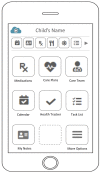User-centered design of a longitudinal care plan for children with medical complexity
- PMID: 33043368
- PMCID: PMC7727350
- DOI: 10.1093/jamia/ocaa193
User-centered design of a longitudinal care plan for children with medical complexity
Abstract
Objective: To determine the content priorities and design preferences for a longitudinal care plan (LCP) among caregivers and healthcare providers who care for children with medical complexity (CMC) in acute care settings.
Materials and methods: We conducted iterative one-on-one design sessions with CMC caregivers (ie, parents/legal guardians) and providers from 5 groups: complex care, primary care, subspecialists, emergency care, and care coordinators. Audio-recorded sessions included content categorization activities, drawing exercises, and scenario-based testing of an electronic LCP prototype. We applied inductive content analysis of session materials to elicit content priorities and design preferences between sessions. Analysis informed iterative prototype revisions.
Results: We conducted 30 design sessions (10 with caregivers, 20 with providers). Caregivers expressed high within-group variability in their content priorities compared to provider groups. Emergency providers had the most unique content priorities among clinicians. We identified 6 key design preferences: a familiar yet customizable layout, a problem-based organization schema, linked content between sections, a table layout for most sections, a balance between unstructured and structured data fields, and use of family-centered terminology.
Discussion: Findings from this study will inform enhancements of electronic health record-embedded LCPs and the development of new LCP tools and applications. The design preferences we identified provide a framework for optimizing integration of family and provider content priorities while maintaining a user-tailored experience.
Conclusion: Health information platforms that incorporate these design preferences into electronic LCPs will help meet the information needs of caregivers and providers caring for CMC in acute care settings.
Keywords: care coordination; chronic disease; health information exchange; hospital medicine; patient care planning; patient portals; pediatrics; transitional care; user-computer interface.
© The Author(s) 2020. Published by Oxford University Press on behalf of the American Medical Informatics Association. All rights reserved. For permissions, please email: journals.permissions@oup.com.
Figures




Similar articles
-
An implementation model for managing cloud-based longitudinal care plans for children with medical complexity.J Am Med Inform Assoc. 2021 Jan 15;28(1):23-32. doi: 10.1093/jamia/ocaa207. J Am Med Inform Assoc. 2021. PMID: 33150404 Free PMC article.
-
Caregiver and Health Care Provider Perspectives on Cloud-Based Shared Care Plans for Children With Medical Complexity.Hosp Pediatr. 2018 Jul;8(7):394-403. doi: 10.1542/hpeds.2017-0242. Epub 2018 Jun 5. Hosp Pediatr. 2018. PMID: 29871887 Free PMC article.
-
Information needs for designing a home monitoring system for children with medical complexity.Int J Med Inform. 2019 Feb;122:7-12. doi: 10.1016/j.ijmedinf.2018.11.011. Epub 2018 Nov 26. Int J Med Inform. 2019. PMID: 30623786
-
What Do Patients and Caregivers Want? A Systematic Review of User Suggestions to Improve Patient Portals.AMIA Annu Symp Proc. 2021 Jan 25;2020:1070-1079. eCollection 2020. AMIA Annu Symp Proc. 2021. PMID: 33936483 Free PMC article.
-
Primary Care Preparation for Children with Medical Complexity for Emergency Encounters in the Community.Pediatr Ann. 2018 Mar 1;47(3):e102-e105. doi: 10.3928/19382359-20180221-02. Pediatr Ann. 2018. PMID: 29538782 Review.
Cited by
-
Feasibility of a Voice-Enabled Medical Diary App (SpeakHealth) for Caregivers of Children With Special Health Care Needs and Health Care Providers: Mixed Methods Study.JMIR Form Res. 2021 May 11;5(5):e25503. doi: 10.2196/25503. JMIR Form Res. 2021. PMID: 33865233 Free PMC article.
-
"Hey Siri, Help Me Take Care of My Child": A Feasibility Study With Caregivers of Children With Special Healthcare Needs Using Voice Interaction and Automatic Speech Recognition in Remote Care Management.Front Public Health. 2022 Mar 3;10:849322. doi: 10.3389/fpubh.2022.849322. eCollection 2022. Front Public Health. 2022. PMID: 35309210 Free PMC article.
-
Using health information technology to support the needs of Children with Medical Complexity: Mapping review of consumer informatics applications.Front Digit Health. 2022 Dec 23;4:992838. doi: 10.3389/fdgth.2022.992838. eCollection 2022. Front Digit Health. 2022. PMID: 36620184 Free PMC article. Review.
-
Caregivers' Experiences With a Web- and Mobile-Based Platform for Children With Medical Complexity and the Role of a Live Platform Coach: Thematic Analysis.JMIR Pediatr Parent. 2023 Jul 5;6:e43214. doi: 10.2196/43214. JMIR Pediatr Parent. 2023. PMID: 37405834 Free PMC article.
-
How Knowledge Mapping Can Bridge the Communication Gap Between Caregivers and Health Professionals Supporting Individuals With Complex Medical Needs: A Study in Fragile X Syndrome.Front Psychiatry. 2021 Nov 24;12:731011. doi: 10.3389/fpsyt.2021.731011. eCollection 2021. Front Psychiatry. 2021. PMID: 34899415 Free PMC article. Review.
References
-
- Bodenheimer T. Coordinating care-a perilous journey through the health care system. N Engl J Med 2008; 358 (10): 1064–71. - PubMed
-
- Antonelli RC, McAllister JW, Popp J, Fund C. Making care coordination a critical component of the pediatric health system: a multidisciplinary framework. The Commonwealth Fund. https://www.lpfch.org/sites/default/files/care_coordination_a_multidisci.... Accessed April 6, 2020
-
- Allshouse C, Comeau M, Rodgers R, Wells N.. Families of children with medical complexity: a view from the front lines. Pediatrics 2018; 141 (Supplement 3): S195–201. - PubMed
Publication types
MeSH terms
Grants and funding
LinkOut - more resources
Full Text Sources
Medical

